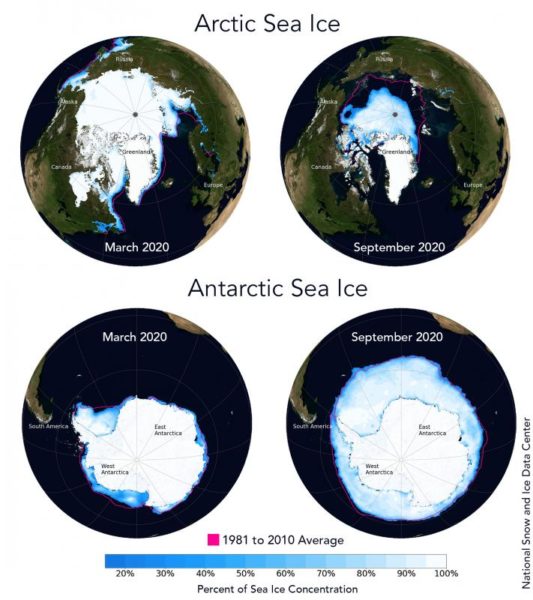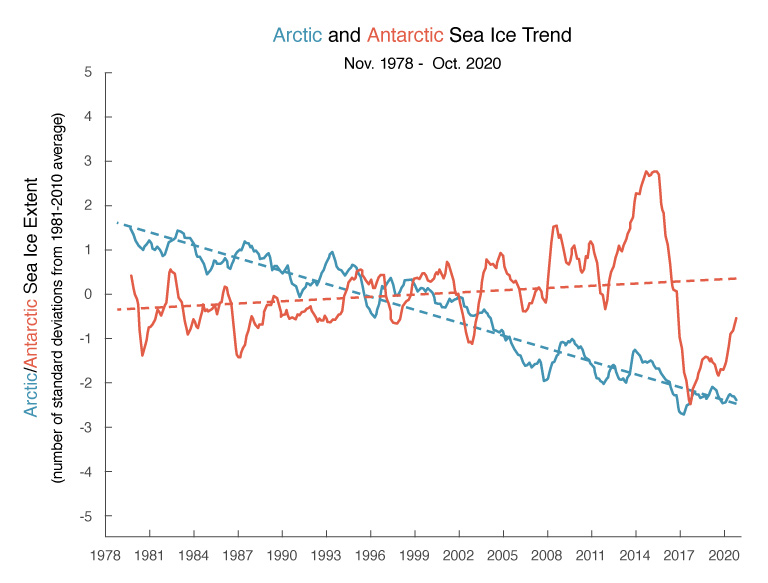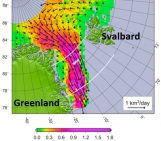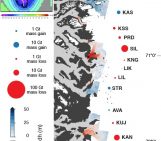
If you look at the maps in Figure 1, you will quickly see that sea ice is present in both polar regions (Arctic at the top, Antarctic at the bottom). Despite this apparent similarity, some differences exist between Arctic (in the Northern Hemisphere) and Antarctic (in the Southern Hemisphere) sea ice. We provide a brief explanation of two key differences in this post.
Geography
The first main difference between Arctic and Antarctic sea ice comes from the geography of the two regions. From the point of view of land/ocean distribution, they are actually the opposite. While the Arctic is a semi-enclosed ocean, which is almost completely surrounded by land (top panels of Figure 1), the Antarctic region is composed of a continent surrounded by the ocean (bottom panels of Figure 1). This has significant consequences in terms of sea-ice motion, thickness and extent.
As the Arctic Ocean is confined by the land around, sea ice tends to stay there longer and has less chance to escape compared to the Antarctic, where sea ice is much more free to move away under the action of wind and ocean currents. Thus, the motion of sea ice is generally larger in the Antarctic. In the Arctic, multiyear sea ice (ice that has survived at least a summer season) is more common than in the Antarctic due to the lower mobility of sea ice.
Due to the longer stay of sea ice in the Arctic, there is more chance that sea ice accumulates and that different floes of sea ice collide with each other, forming ridges. This can lead to relatively thick sea ice (up to 20 m). In the Antarctic, there is no such opportunity for sea ice to thicken that much. On average, sea-ice thickness is 2-3 m in the Arctic, while it is only 1-2 m in the Antarctic. To put things in perspectives, sea ice typically grows by 1.5-2 m in the Arctic during one single winter season (see this article).
What we see in Figure 1 is that even if a great portion of the Arctic sea-ice cover has melted from winter (top left panel) to summer (top right panel), the decrease is smaller compared to the Antarctic (from bottom right to bottom left panel). Note that the seasonal cycle of sea ice is reversed in the Arctic and Antarctic as the Northern Hemisphere summer (winter) corresponds to the Southern Hemisphere winter (summer). This is more obvious when looking at the mean seasonal cycle of sea ice in both polar regions: the maximum extent in the Arctic is about 16 million km² and goes down to about 6 million km² in the summer, while in the Antarctic the maximum extent is about 18 million km² and the minimum extent is about 3 million km² (1981-2010 average). This means that a significant proportion of Arctic sea ice (about 35%) remains during the summer and continues to grow the following autumn and winter.
Recent evolution
Since the beginning of satellite observations (1979), there has been a strong decline in Arctic sea-ice extent (blue curve in Figure 2), while there has been no clear change in sea ice in Antarctica over the whole period (red curve in Figure 2) (see this post). The absence of clear signal in Antarctica is partly due to strong year-to-year variability (there has been a slight increase in sea-ice extent until around 2014 followed by large decreases the following years) and partly due to the compensation of changes between different regions (increase in sea-ice extent in some regions and decrease in other regions) (see Chapter 9 of the IPCC AR6 WGI report for further details).
The loss of Arctic sea ice since the beginning of satellite observations is more pronounced in the summer compared to the winter, and it is projected that we will have an almost ice-free Arctic in the summer before the middle of this century (see this post). In this case, the Arctic would share more similarities with the Antarctic in terms of seasonal cycle, with almost no sea ice in the summer.

Figure 2: Time evolution of Arctic (blue curve) and Antarctic (red curve) sea-ice extent, expressed in terms of deviation from 1981-2010 average, based on satellite observations [Credit: National Snow and Ice Data Center, University of Colorado, Boulder].
We hope that now you know more about key differences in sea ice between the two polar regions!
Further reading
- National Snow and Ice Data Center
- Arctic and Antarctic Sea Ice: How are they different? NASA Vital Signs of the Planet
- Burgard (2017) The ups and downs of sea ice! EGU Cryoblog post
Editeb by Ugo Nanni and Giovanni Baccolo
 Hayat Nasirova is geographer and teacher with a background in education. She is an experienced science communicator, especially with respect to the intersection of science and contemporary art, having led masterclasses and workshops integrating and articulating scientific phenomena on art and canvas. She runs a series of courses called “The History of Science” and “Sci-Art”.
Hayat Nasirova is geographer and teacher with a background in education. She is an experienced science communicator, especially with respect to the intersection of science and contemporary art, having led masterclasses and workshops integrating and articulating scientific phenomena on art and canvas. She runs a series of courses called “The History of Science” and “Sci-Art”.
 David Docquier is a post-doctoral researcher at the Royal Meteorological Institute of Belgium. His study focuses on the interactions between the ocean and atmosphere using tools from nonlinear sciences. His work is embedded within the JPI-Oceans/JPI-Climate ROADMAP project.
David Docquier is a post-doctoral researcher at the Royal Meteorological Institute of Belgium. His study focuses on the interactions between the ocean and atmosphere using tools from nonlinear sciences. His work is embedded within the JPI-Oceans/JPI-Climate ROADMAP project.


![Image of the Week – On thin [Arctic sea] ice](https://blogs.egu.eu/divisions/cr/files/2018/10/kayak-161x141.jpg)

